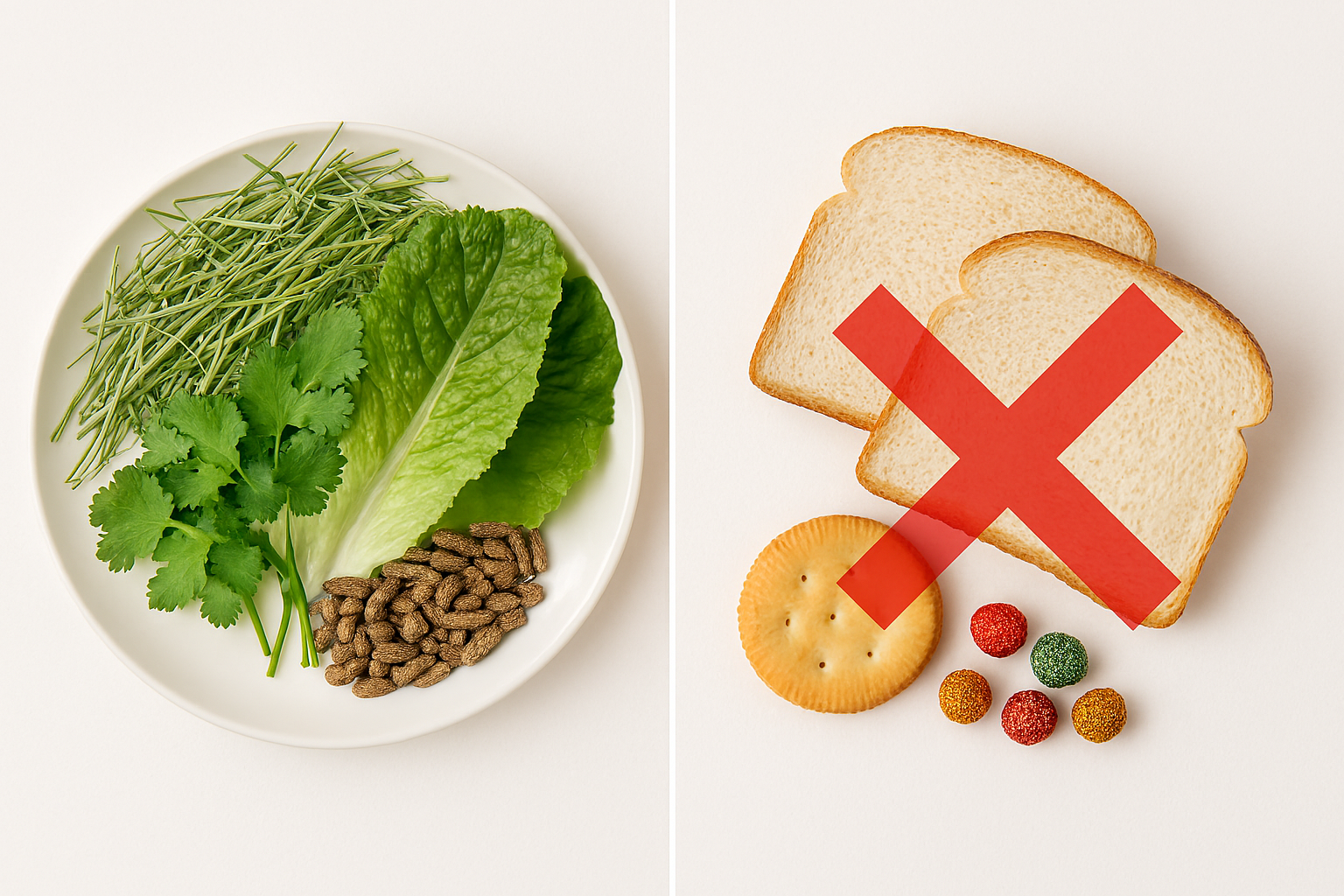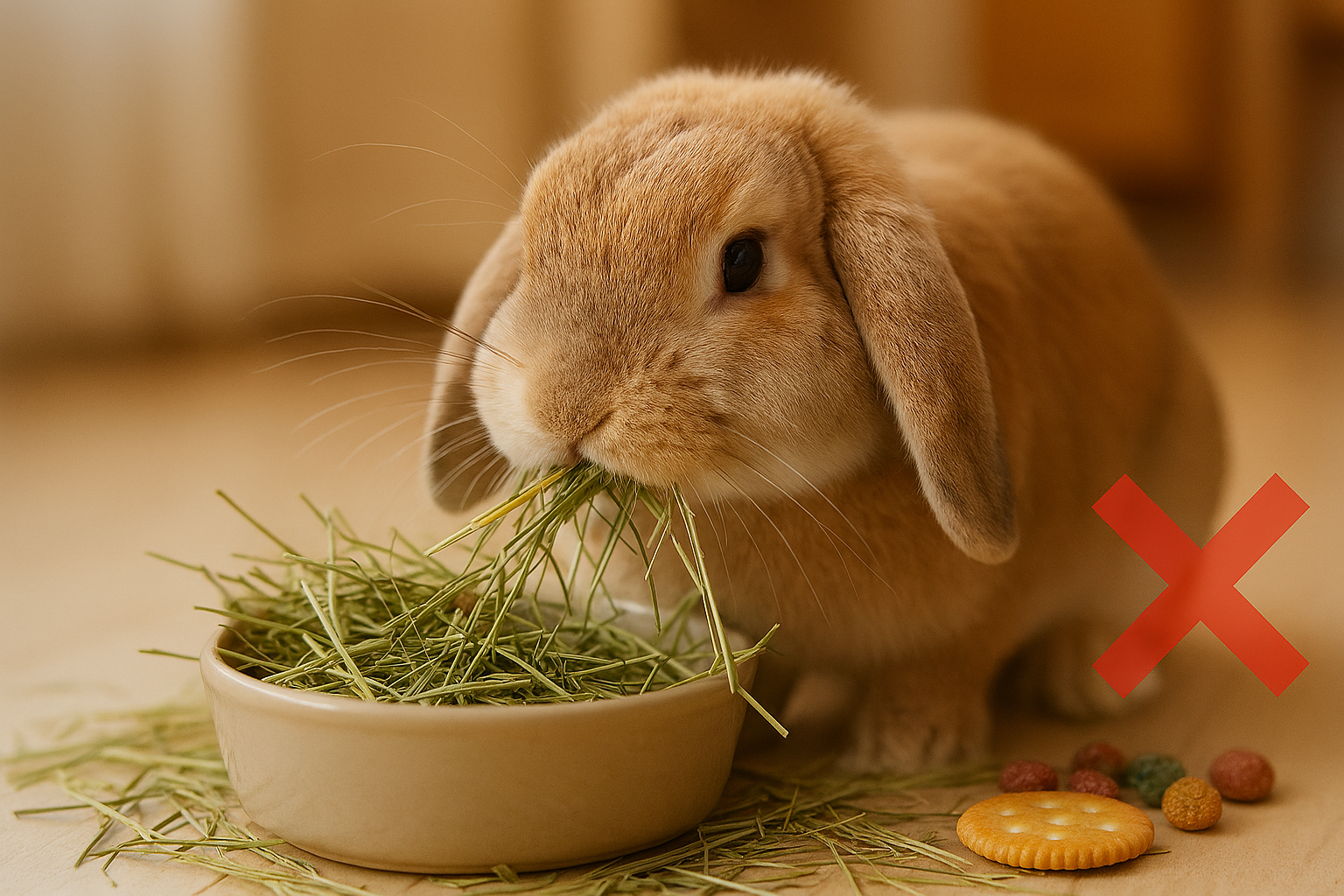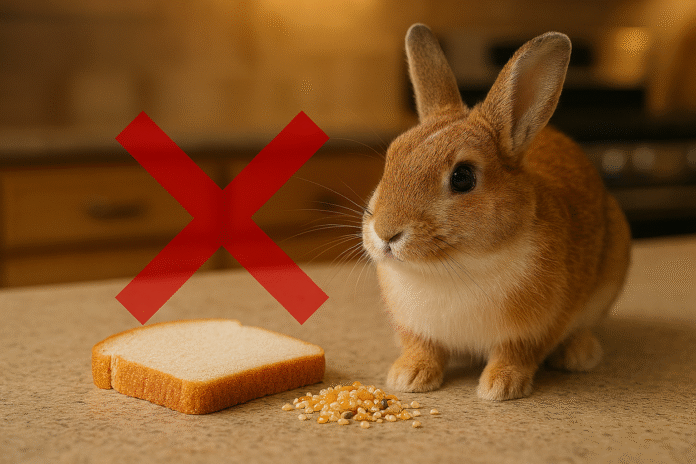My rabbit Pepper taught me this lesson the expensive way. Found her one morning looking absolutely miserable after she’d somehow gotten into a loaf of bread I’d left on the counter. That vet visit cost me $200 and a lot of worry.
Yes, rabbits will eat bread if you give it to them. But should they? Absolutely not. And I’m going to tell you exactly why, plus what happened when I ignored this advice early on.
Why Rabbits Shouldn’t Eat Bread (Even Though They Want To)

Here’s what I wish someone had told me when I first got Pepper three years ago: just because a rabbit will eat something doesn’t mean it’s good for them. Rabbits are like toddlers – they’ll try to eat anything you put in front of them.
Bread is basically empty calories for rabbits. Their digestive systems are designed to process high-fiber foods like hay and leafy greens. When you give them bread, you’re filling them up with stuff that doesn’t provide the nutrients they need.
I learned this after watching Pepper get sluggish and stop eating her hay properly. Took me a while to connect it to the small pieces of toast I’d been sharing with her during breakfast. Felt terrible when the vet explained what I was doing wrong.
What Actually Happens When Rabbits Eat Bread
Rabbit digestive systems are complicated. They need to keep food moving through constantly, and they do this thing called cecotrophy where they actually eat special soft poops to get all the nutrients they need. Sounds gross, but it’s totally normal for them.
When you give them bread, several bad things can happen. First, it can cause what’s called GI stasis – basically their digestive system slows down or stops. This is a medical emergency for rabbits and can kill them.
Second, bread can cause gas and bloating. Rabbits can’t burp or vomit like we can, so gas gets trapped and causes serious pain. I’ve seen Pepper when she’s gassy from eating the wrong things, and it’s heartbreaking.
The yeast in bread is particularly bad. It can continue fermenting in their stomach, creating more gas and potentially dangerous bacteria overgrowth.
Signs Your Rabbit Ate Something They Shouldn’t Have
Trust me, you’ll know. Pepper gets this hunched posture and stops moving around much. She’ll sit in one spot looking miserable and won’t touch her favorite foods.
Other warning signs include small or no poops (rabbits normally poop constantly), teeth grinding (they do this when they’re in pain), and refusing to eat hay. If you see any of these, call your vet immediately.
Sometimes rabbits will eat the bread and seem fine initially, but problems can develop over the next 12-24 hours. Don’t assume everything’s okay just because they’re acting normal right after eating it.
What About Different Types of Bread?
People always ask me if whole grain bread is better, or what about just a tiny piece. The answer is still no to all of it. White bread, whole wheat, sourdough, bagels, crackers – none of it is appropriate for rabbits.
I made the mistake of thinking whole grain bread was healthier and gave Pepper a small piece. She still had digestive issues. The fiber in bread isn’t the right kind of fiber for rabbits.
Even “healthy” breads often have seeds, nuts, or sweeteners that can be harmful to rabbits. It’s just not worth the risk.
What Rabbits Should Actually Eat
This is where I really want to help people avoid my mistakes. Rabbits need unlimited timothy hay – this should make up about 80% of their diet. I go through a bale of hay every few weeks with just one rabbit.
Pellets should be plain timothy hay pellets, about 1/4 cup per day for an average-sized rabbit. Not the colorful mixes with dried fruit and seeds. Those are basically rabbit junk food.
Fresh vegetables are great, but introduce them slowly. Pepper loves romaine lettuce, cilantro, and bell peppers. I avoid iceberg lettuce (no nutritional value) and anything in the onion family.
Fruits are treats only – maybe a small piece of apple or banana once or twice a week. Pepper goes crazy for dried papaya, which actually helps prevent hairballs.
Emergency Foods You Can Give Rabbits
Sometimes people ask what to do if they run out of rabbit food and the pet store is closed. Here’s what’s actually safe in a pinch:
Plain romaine lettuce, cilantro, parsley, or carrot tops from your grocery store. Small amounts of plain rolled oats (not the flavored packets) are okay temporarily. Timothy hay from a feed store if you can find it.
Never give iceberg lettuce, chocolate, anything with caffeine, onions, garlic, or anything sugary. And obviously no bread, even in emergencies.
Other Pets and Bread – What’s the Deal?
Since we’re talking about pets and bread, I should mention that other animals have different rules. My friend’s dog can handle small amounts of plain bread occasionally, though it’s not nutritionally great for dogs either.
Cats are obligate carnivores, so bread doesn’t do much for them. Most cats won’t even bother with it. My cat Murphy sniffs bread and walks away.
Birds can actually eat certain types of bread in very small amounts, but it should never be a regular part of their diet either. Wild birds definitely shouldn’t be fed bread – it can cause serious malnutrition in bird populations.
Common Questions About Rabbit Diet
What if my rabbit already ate some bread? Monitor them closely for the next 24 hours. If they stop eating, pooping, or seem uncomfortable, call your vet immediately. Small amounts might pass through okay, but watch for problems.
Can rabbits have crackers or cookies? Nope. Same problems as bread, often with added salt, sugar, or chocolate that’s even worse for them.
What about bread crusts? Still no. The crust is just dried bread – same issues apply.
Is toast better than regular bread? Not really. Toasting doesn’t change the fundamental problems with bread for rabbits.
How to Rabbit-Proof Your Kitchen

After Pepper’s bread incident, I had to get smart about keeping human food away from her. Rabbits are surprisingly good at getting into things.
I moved my bread box to a high shelf and always put loaves away immediately. Learned this after finding Pepper had chewed through a plastic bag to get to a bagel.
Cabinet locks work if your rabbit is persistent. Pepper figured out how to open lower cabinets, so I had to baby-proof them just like you would for a toddler.
Keep all human snacks in sealed containers or high places. Rabbits can jump higher than you’d expect, and they’re determined when they smell something interesting.
Building a Proper Rabbit Diet
Getting Pepper’s diet right took some trial and error. I started by finding a good local source for timothy hay – it’s way cheaper buying in bulk than those tiny pet store bags.
For vegetables, I introduce one new thing at a time and watch for any digestive upset. Some rabbits are more sensitive than others. Pepper can handle most greens, but too much kale gives her gas.
I keep a feeding schedule posted on my fridge so everyone in the house knows what and when to feed her. Consistency really matters for rabbit digestion.
Treats should be truly occasional. I use tiny pieces of banana or apple for training, but never more than a tablespoon per day total.
Working with Your Vet on Rabbit Nutrition
Find a vet who actually knows rabbits. Not all vets are experienced with rabbit care, and the wrong advice can be dangerous. My first vet told me to feed Pepper a seed mix that would have been terrible for her.
Ask about transitioning diets if you need to change foods. Rabbits have sensitive digestive systems, and sudden changes can cause problems. Always transition gradually over 7-10 days.
Get your rabbit’s weight checked regularly. Weight loss in rabbits can indicate serious health issues, and overweight rabbits have their own set of problems.
Signs of a Healthy Rabbit Diet

When Pepper’s diet is right, she’s active and curious. She produces plenty of normal-sized round poops and those soft cecotropes that she eats directly (still weird to watch, but totally normal).
Her coat stays soft and shiny, and she maintains a steady weight. She’s alert and interested in her surroundings, not lethargic or hunched up.
Most importantly, she’s eager to eat her hay and pellets. If a rabbit starts refusing their normal food, something’s wrong.
Cost-Effective Rabbit Feeding
Feeding a rabbit properly doesn’t have to break the bank. Buying hay in bulk from feed stores is way cheaper than pet store bags. I pay about $15 for a bale that lasts over a month.
Growing your own rabbit-safe herbs like cilantro and parsley can save money on vegetables. Pepper loves fresh herbs, and they’re easy to grow on a windowsill.
Generic timothy hay pellets are usually just as good as expensive brands. Check the ingredients – if it’s just timothy hay with no added colors or flavors, you’re good.
Final Thoughts on Rabbits and Human Food
Three years of rabbit ownership have taught me that rabbits are happiest and healthiest on a simple, species-appropriate diet. I know it’s tempting to share your food with them – Pepper gives me those adorable begging eyes every time I eat anything.
But keeping her healthy means saying no to bread, crackers, cookies, and all the other human foods she’d probably love to try. The vet bills I’ve saved by sticking to proper rabbit food have more than paid for the initial learning curve.
If you’re new to rabbit ownership, do yourself and your rabbit a favor – learn about proper diet from the start. Your rabbit will live longer and be healthier, and you’ll avoid the stress and expense of digestive emergencies.
And please, keep that bread somewhere your rabbit can’t reach it. Trust me on this one.



